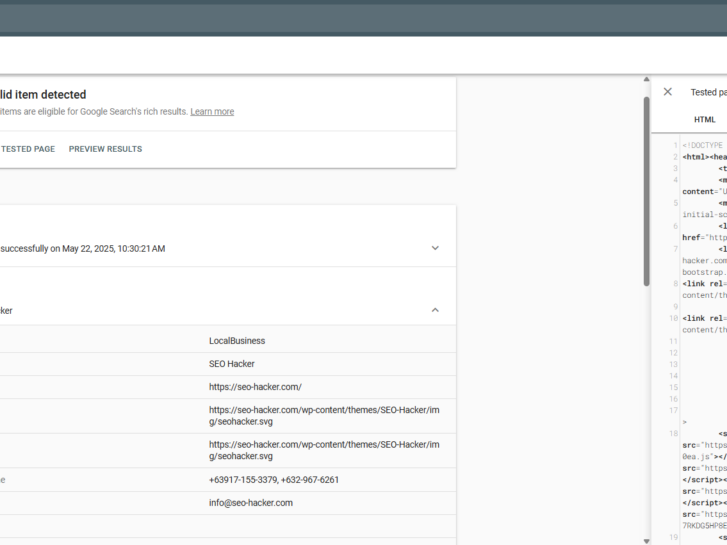How to Add LocalBusiness Schema for More Local Search Visibility
Running a local business and getting it noticed online isn’t as simple as listing your information on your website and hoping customers find you. It takes strategic optimization—particularly for local search.
One effective way to do this is knowing how to add LocalBusiness schema markup to your website. With that in your toolkit, you not only increase your chances of showing up in local packs and map listings, but can enhance your overall SEO visibility too.
What is LocalBusiness Schema?
LocalBusiness schema is a form of structured data markup by Schema.org, which can be added to your website to help search engines to understand your business. It provides detailed information like your business name, address, phone number, and operating hours.
LocalBusiness is actually a subtype of the broader Organization schema, designed for businesses that serve a specific area that allows businesses to include more relevant, location-based details.
With this schema type being used for your website, you make it easier for search engines to display your business details right in the search results, often in eye-catching formats called rich snippets. This means more chances for local customers to notice you and drive more traffic to your business.
Why LocalBusiness Schema Matters for Local SEO?
While often overlooked, LocalBusiness schema plays a big role in enhancing your visibility in local search results. It allows search engines to better understand and present your business to the right audience at the right time. It’s a simple way to give your local SEO a powerful edge.
- Improved search result visibility. Adding LocalBusiness schema markup leads to enhanced visibility with features like rich snippets, local packs, and knowledge panels. This helps your business stand out and attract more attention from potential customers searching nearby.
- Enhanced local search rankings. With this schema markup applied, search engines can better assess your relevance for local queries, which can lead to higher placement in local search results.
- Increased click-through rates. Search listings will be more informative and visually appealing through rich snippets. So when users see key details of your website upfront, they are more likely to click on your link over others.
- Better accuracy and consistency. Search engines will be able to receive accurate and consistent information about your business directly from your website. This reduces the chances of outdated or incorrect details appearing in search results, which can help build trust with both search engines and potential customers.
Author’s Note: Adding schema markups to your SEO strategy is an easy and indirect way of boosting your rankings and visibility on search. To support you in this, I’ve launched a series of practical guides. Start exploring with my tutorials on adding AggregateRatings, Organization, VideoObject, and Event schema to your site.
Properties You Should Include in Your LocalBusiness Schema Markup
Getting the most out of your LocalBusiness schema involves adding the required and recommended properties. These include:
| Property | Description | Required? |
| @context | Always “https://schema.org” | Yes |
| @type | Always “LocalBusiness” or a more specific subtype (e.g., “Restaurant”) | Yes |
| name | Name of your business | Yes |
| image | URL of your logo or relevant image | No, but recommended |
| @id | Unique identifier for your business page (usually your homepage URL) | No, but recommended |
| url | Website URL of the business | Yes |
| telephone | Business phone number | Yes |
| address | Full business address in PostalAddress format | Yes |
| geo | Latitude and longitude of the business location (GeoCoordinates) | No, but recommended |
| areaServed | The geographic area where a service or offered item is provided. | No, but recommended |
| openingHoursSpecification | Days and times the business is open | No, but recommended |
| priceRange | Typical cost range (e.g., “$$”, “₱₱₱”) | No, but recommended |
| paymentAccepted | Cash, Credit Card, Cryptocurrency, Local Exchange Tradings System, etc. | No, but recommended |
| sameAs | Links to social media or business profiles (e.g., Facebook, Google Maps) | Optional |
| aggregateRating | Average rating from reviews | No, but recommended |
| review | Individual customer reviews | Optional but helpful |
How to Add LocalBusiness Schema Markup
Adding LocalBusiness schema markup is easier than you might think, and well, worth the effort. With just a few steps, search engines can understand and highlight your business in the local search results better.
Gather Your Business Information
Start by collecting all the important details about your business. Here’s what you’ll need:
-
- Business name – Your official or registered business name.
- Full address – Include street, city, state, ZIP code, and country to ensure accuracy in location based-searches.
- Phone Number – A local contact number that customers can use to reach you.
- Website URL – The official link to your business website.
- Business Hours – Daily operating hours.
- Business Category/Type – The kind of local business you run (e.g.: Restaurant, HairSalon, ClothingStore). Here is a list of business categories from Schema for your reference.
- Geo-Coordinates (Latitude & Longitude) – To pinpoint your business location more precisely on maps.
- Logo or Relevant Image – A visual identifier, such as your brand logo or storefront image.
Having all of this information ready will make it easier to add your LocalBusiness schema markup, while ensuring that your business is accurately and consistently represented across search results.
Create the JSON-LD Schema Markup
Google strongly prefers the JSON-LD format for adding structured data to a webpage. It is easy to implement, cleanly separates code from content, and allows search engines to efficiently read and process the information.
Here’s an example (that you can also modify and use):
<script type=“application/ld+json”>
{
“@context”: “https://schema.org”,
“@type”: “LocalBusiness”,
“name”: “SEO Hacker”,
“url”: “https://seo-hacker.com/”,
“image”: “https://seo-hacker.com/wp-content/themes/SEO-Hacker/img/seohacker.svg”,
“logo”: “https://seo-hacker.com/wp-content/themes/SEO-Hacker/img/seohacker.svg”,
“telephone”: “+63917-155-3379”,
“email”: “[email protected]”,
“address”: {
“@type”: “PostalAddress”,
“streetAddress”: “3F, Unit C, C&C building, Aguirre Avenue, BF Homes”,
“addressLocality”: “Paranaque”,
“addressRegion”: “Metro Manila”,
“postalCode”: “1720”,
“addressCountry”: “PH”
},
“openingHours”: “Mo-Fr 09:00-18:00”,
“priceRange”: “$$”,
“aggregateRating”: {
“@type”: “AggregateRating”,
“ratingValue”: “4.9”,
“ratingCount”: 18
},
“contactPoint”: {
“@type”: “ContactPoint”,
“telephone”: “+639171553379”,
“contactType”: “sales”
},
“sameAs”: [
“https://plus.google.com/+Seohackerpage/about”,
“https://seo-hacker.com/”,
“https://seo-hacker.org/”,
“https://www.facebook.com/SEOHacker/“,
“https://twitter.com/seo_hacker”,
“https://www.linkedin.com/company/seo-hacker”
]
}
script>
You can customize these values with any of the relevant details of your business.
Add the Schema Markup to Your Website
Once you’ve created your JSON-LD schema markup, copy the entire block and paste it into your website’s HTML—either in the section or just before the closing tag. If you’re using a CMS like WordPress, you can easily insert the code using a plugin or by adding it to a custom HTML block.
Testing Your LocalBusiness Schema
After adding your LocalBusiness schema, it is important that you should test it using tools like Google’s Rich Results Test. It’s a quick way to check if your markup is working properly, see what features might show up in search, and identify errors or warnings you might need to fix.
It’s a quick way to check if your markup is working properly, see what features might show up in search, and identify errors or warnings you might need to fix.
Best Practices for Adding LocalBusiness Schema to Your Website
To ensure your LocalBusiness schema delivers the best results, it’s important to follow key best practices:- Keep business info consistent with other online listings (NAP consistency) to build trust with search engines and strengthen your local credibility. Inconsistencies can confuse both search engines and potential customers, which can potentially hurt your SEO performance as well.
- Regularly update schema markup to reflect any changes in business hours, contact details, and other key information to ensure that search engines will always have the most accurate data. This will help maintain your visibility in the local search results, and avoid misleading potential customers.
- For the best results, combine your LocalBusiness schema with other local SEO strategies like optimizing GMB (Google My Business) profile, and building citations consistently. These will boost your online presence, while improving your chances of appearing in local search and map results as well.
Key Takeaway
Adding LocalBusiness schema markup to your website is an easy way to get noticed in local search results.With the right info in the right format (and keeping everything consistent), you will boost your chances of attracting more local customers and staying ahead of the competition.Source link

